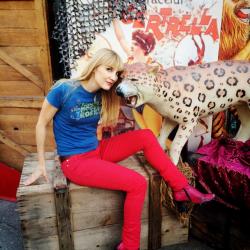
The Starlet, built in 1957, located across from Warner Bros Studios on the corner of Pass and Warner Avenues in Burbank (photo by Nikki Kreuzer)
They are as common as the dreamers that flock to our fair city in hopes of their big breaks. They are disparaged and celebrated almost in the same breath. With their utilitarian boxy structures and their lofty and hopeful names written in extra large font across their facades, they give the impression that they are on their way up, striving for the next level of social status.
Dingbat Apartments, original to the sunbelt region of our country and ubiquitous to L.A., are in themselves not so unique. They are cookie cutter 2-story walk-ups, many with semi-sheltered parking on street level. What makes them stand out and cry, “Pick me! I am special!” are the surface flourishes, the added embellishments, the mid-century elements used to dress up the exteriors. Often far too optimistic for the realism that their shoebox interiors actually hold, their elaborate names are undelivered promises, the highest form of irony. They imply grandeur and fall woefully short, like wannabe actresses who rely solely on their sexuality to land the part.
Many are titled to conjure images of British royalty, often taking the name of the street where the dingbat is located and adding a hyperbolic housing style as a flourish. Villas, manors, chateaus, arms, gardens, courts and estates are common. Others promise tropical paradise – oasis, palms, capri or lanai. There are those that honor long forgotten women, perhaps a lost love, a daughter or a mother. Some combine names of cross streets to create entirely new words and others are simply without category. What they have in common is the intention to be something they’re not. Their documentation in the 1998 dark comedy The Slums of Beverly Hills, in which a low-income family moves every few months to stay in the prestigious Beverly Hills school district, aptly captures the hypocritical double entendre of the dingbat. The main character, an all-too-wise teenager, upon seeing her family’s new apartment sardonically complains, “Another dingbat – that’s what they’re called. Dingbats. Two story apartment buildings featuring cheap rents and fancy names. They promise the good life but never deliver.”
Southern California’s love affair with this inexpensive architectural style started about a decade after the veterans of the 2nd World War returned home. The late 1950s to mid 1960s were a time of extreme optimism. During the seven years between 1957-1964 the population of Los Angeles County grew by 1.2 million people. The fascination with the automobile, the space program, television and teen-age culture gave life a new sense of mobility, impermanence and disposability. Old Victorian single-family homes and bungalows were knocked down to build multi-unit complexes. The cheap construction associated with the functional dingbat style gave landlords much more bang for their buck. After a coat of paint and some fanciful touches to give the impression of elegance to potential renters, they were good to go. The building era of the dingbat was short lived, however, lasting approximately 20 years, with its peak being 1957-1964. By the mid-70s zoning laws began prohibiting the back-out parking that most dingbats are known for and underground parking and even bigger buildings became the rage.

Built in 1964 on Stoner Avenue in Los Angeles, the name of this dingbat was ahead of its time (photo by Nikki Kreuzer)
Lately, perhaps because they now qualify as truly vintage, there has been a growing appreciation of the kitsch aspect of the dingbat. And of course, in a city like ours that is always moving on to the next big thing, these smaller buildings are now being replaced in many high-rent areas with monster condo complexes. The quaint dingbat, with it’s simplicity and hip, Mad Men era artistic touches are now as endangered as everything else from the past. One local photographer, Lesley Marlene Siegel, has been documenting the Southern California dingbat in photos since the 1990s. Her catalog now comprises over 2,300 images and culminated in a 2003 solo show called Apartment Living is Great. Another Los Angeles artist, Clive Piercy, published a 480-image photography book the same year entitled Pretty Vacant: The Los Angeles Dingbat Observed.

The Crapi Apartments on Overland Avenue in Palms. Built in 1960 it is almost certain that a sarcastic new owner changed the name (photo by Nikki Kreuzer)
Whether lauded for their tacky innocence or criticized for their unoriginal construction, dingbats are an important part of Los Angeles history. You may agree with this or you may not. As time continues to pass, nostalgia almost always gives things an eminence that they never originally possessed. The dingbat was always striving for that social foothold, always trying to be better than its neighbors. Perhaps its glory time has finally come. Perhaps the dingbat has finally arrived.






I never knew they had a name!
Yes! There’s a great (but sadly, all in black and white!) book of dingbats. Well done, Nicole-I’m a big fan of dingbats myself (I lived in a great one in the Valley for years) and have some nice pix, though not as good as these. I love the Crapi!
“Crapi” – Hilarious!! Cool pix!
Did you ever see the “Leonard Jay” on the Westside?!
There’s also the Chee-Zee building, located nearby. https://www.flickr.com/photos/joebehr/5361828232/
http://www.laparks.org/dos/reccenter/facility/stonerRC.htm
They are also know as “soft story” buildings in geology worlds. AKA, the most likely to fall down during an earthquake.
http://science.howstuffworks.com/engineering/structural/soft-story-seismic-retrofitting.htm
I’m a huge fan of Googie architecture, great article!